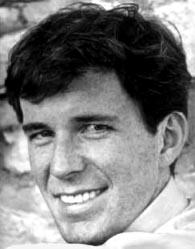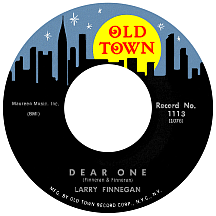LARRY FINNEGAN
Dear One
When a singer's first record becomes a hit, that's great. If it starts looking like there won't be another, some "out of the box" thinking may be in order. Focusing on live performances, dancing, hosting, acting or joining a panel on a TV game show...all have been attempted with varying results. A great many determined showbiz folks have done whatever it took to continue working as an entertainer. For New Yorker John Lawrence Finneran, the way was fraught with compromises; he changed his last name to "Finnegan," simply because it seemed easier to pronounce and for people to remember. Later, John...make that Larry...made a tougher decision: he moved to a foreign country.
Vincent Finneran mirrored his brother's love of music and the two often wrote songs together. Larry learned to play guitar and, just for good measure, added piano, drums and two or three more instruments to his skill set. He and Vince hawked their pop compositions to various N.Y. record companies in 1961 and found a taker in Hy Weiss of Old Town, a label that had primarily released rhythm and blues material over its eight-year existence. Breakup song "Dear One" ('...I opened up and read your last letter...') was recorded that fall by Larry with a female session vocalist taking a spoken role, repeating the letter's heave-ho message: 'I tried so hard not to give in...but I lost my head and I lost my heart and I lost your love to him.' The finished take fit right in with the prevailing teen sound while moving at a slightly more rocking pace; his adjusted name adorned the labels (writer credits remained Finneran) but his ex-steady adversary was not identified. The single was pressed on both the earlier light blue Old Town 45s and redesigned mostly-black labels.
Larry Finnegan didn't sit around waiting for his debut disc to soar. He continued making the rounds and found another taker in Paul Cohen of Decca's Coral division. "There Ain't Nothin' in This World" resulted, a pop tune with a country feel cowritten by Bobbi Martin, who'd recently signed with the label as a singer and would later have a few hits of her own (the biggest: "For the Love of Him" in 1970). This modification to Finnegan's style, on just his second release, foreshadowed an eventual transition to country music. But wait..."Dear One" began popping up on top 40 playlists in early '62; many listeners mistook it for Del Shannon's latest until head-to-head comparisons with Del's recent hits confirmed the obvious difference. The single reached number eleven during an eight-week run in the top 40, quelling competition from Darrell McCall on Philips and a U.K. cover by Joe Meek discovery Tony Victor, though neither Larry's nor Tony's version was successful in Britain. What was significant was the song's popularity in Australia and many European countries including Sweden (where it hit number one), Norway, Denmark and The Netherlands.

Old Town boss Weiss, ecstatic over his successful entry into the teen market where there were plenty of big bucks to be made (or so he figured), followed the hit with "Pretty Suzy Sunshine," another Finneran-Finneran tune, but it missed the charts (save for a few weeks in June on the Cash Box "Looking Ahead" list). The country mindset kicked in, but a remake of Don Gibson's "Oh Lonesome Me" came up a no-show. There was one more on Old Town, "A Kiss and a Dozen Roses," before Hy cut Larry loose. Meanwhile, his records were selling well throughout much of Europe. That final Old Town single, issued in Sweden on Sonet, did quite well as did several covers of American hits including a double-tracked take on the two-year-old Chris Kenner hit "I Like it Like That."
A couple of singles on the Ric label appeared in 1964. "Dear One, Part Two" dealt with a second letter from his former ladylove disclosing her plans to come home ('I'm sorry my love that I made you blue...but I'll make it up to you') and featured the same unnamed female vocalist, or someone who did an excellent imitation of her. It was a desperate move on par with so many other "one-hit" artists...an unnecessary one, as it turns out. He followed it with "A Tribute to Ringo Starr - The Other Ringo," a novelty number that served double duty as an answer to Lorne Greene's gunslinging, chart-topping "Ringo" and a half-baked homage to The Beatles' blinged-out beat-keeper. Its popularity was limited to record collectors, more specifically Beatles novelty completists.
Finnegan could have packed it in, but instead he went where the action was and moved to Sweden. He started Svensk American Records in 1965 and scored several more hits including country ballad "Good Morning, Tears" in '66, the Johnny Cash-ish "Bound For Houston" in '67 and "Maria Min Van," a number one summer '67 hit sung in the Swedish language. He also recorded in German for Deutschland's Vogue Records. After returning to the U.S. due to health problems, he settled in North Bend, Indiana. A brain tumor tragically ended Larry Finnegan's life in 1973 at age 34. In much of Europe his passing was big news. In America, hardly anyone noticed.


